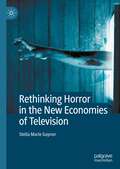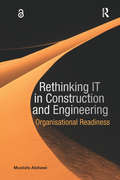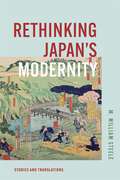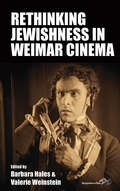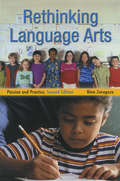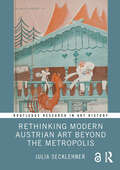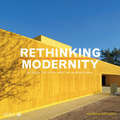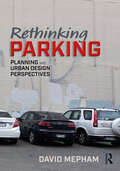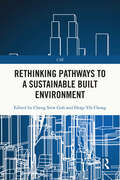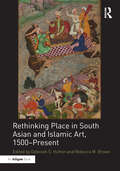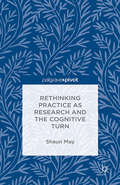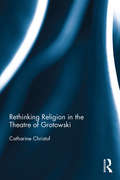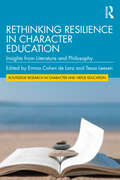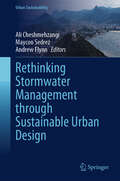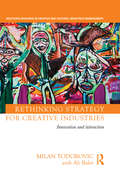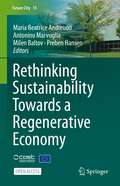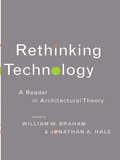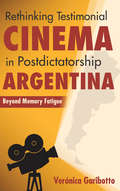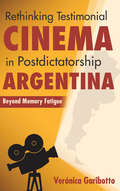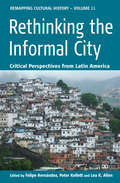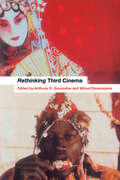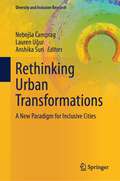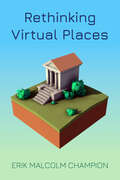- Table View
- List View
Rethinking Horror in the New Economies of Television
by Stella Marie GaynorThis book explores the cycle of horror on US television in the decade following the launch of The Walking Dead, considering the horror genre from an industrial perspective. Examining TV horror through rich industrial and textual analysis, this book reveals the strategies and ambitions of cable and network channels, as well as Netflix and Shudder, with regards to horror serialization. Selected case studies; including American Horror Story, The Haunting of Hill House, Creepshow, Ash vs Evil Dead, and Hannibal; explore horror drama and the utilization of genre, cult and classic horror texts, as well as the exploitation of fan practice, in the changing economic landscape of contemporary US television. In the first detailed exploration of graphic horror special effects as a marker of technical excellence, and how these skills are used for the promotion of TV horror drama, Gaynor makes the case that horror has become a cornerstone of US television.
Rethinking IT in Construction and Engineering: Organisational Readiness
by Mustafa AlshawiHow could the potential of IT be realised to improve business performance in architecture, construction and engineering organisations? How could organisations unleash the potential of IT to achieve a sustainable competitive advantage? How can organisations migrate from technology to IT-enabled business thinking? Based on the author's twenty years research experience, this book provides a holistic picture of the factors that enable architecture, construction and engineering organisations to explore the potential of IT to improve their businesses and achieve a sustainable competitive advantage. It raises awareness of the importance of the organisational 'soft issues' and the role they play in influencing the outcome of IT investments as well as addressing other complementary enablers, such as knowledge management, learning organisations, maturity models and e-readiness measurements. Real case studies are used throughout the book to illustrate various concepts and to provide the reader with a realistic and practical picture. Rethinking IT in Construction & Engineering is ideal for lecturers and researchers in architecture, construction and engineering as well as professionals at managerial level in industry.
Rethinking Japan's Modernity: Stories and Translations (Harvard East Asian Monographs #473)
by M. William SteeleHistory is not one story, but many. In Rethinking Japan’s Modernity, M. William Steele takes a new look at the people, places, and events associated with Japan’s engagement with modernity, starting with American Commodore Matthew Perry’s arrival in Japan in 1853. In many cases, this new look derives from visual sources, such as popular broadsheets, satirical cartoons, ukiyo-e and other woodblock prints, postcards, and photographs. The book illustrates the diverse, and sometimes conflicting, perceptions of people who experienced the unfolding of modern Japan. It focuses both on the experiences of people living the events “at that time” and on the reflections of others looking back. Also included are three new translations—two of them by Japan’s pioneer Westernizer, Fukuzawa Yukichi, and another by Mantei Ōga—parodying Fukuzawa’s monumental work advocating Western learning. These and other stories show how Japanese views of modernity evolved over time. Each chapter is prefaced with a short introduction to the topic covered and historiographical approach taken, allowing each to stand alone as well as support the overall goal of the work—to inform and challenge our understanding of the links between Japan’s past, present, and future.
Rethinking Jewishness in Weimar Cinema (Film Europa #24)
by Barbara Hales and Valerie WeinsteinThe burgeoning film industry in the Weimar Republic was, among other things, a major site of German-Jewish experience, one that provided a sphere for Jewish “outsiders” to shape mainstream culture. The chapters collected in this volume deploy new historical, theoretical, and methodological approaches to understanding the significant involvement of German Jews in Weimar cinema. Reflecting upon different conceptions of Jewishness – as religion, ethnicity, social role, cultural code, or text – these studies offer a wide-ranging exploration of an often overlooked aspect of German film history.
Rethinking Language Arts: Passion and Practice (Sociocultural, Political, and Historical Studies in Education)
by Nina ZaragozaIn Rethinking Language Arts: Passion and Practice, Second Edition, author Nina Zaragoza uses the form of letters to her students to engage pre-service teachers in reevaluating teaching practices, thus bringing to life a vision of an alternative classroom environment in which the teacher is the prime mover and creative leader. Zaragoza discusses and explains the need for teachers to be decision makers, reflective thinkers, political beings, and agents of social change in order to create a positive and inclusive classroom setting. This book is both a critical text that deconstructs the way language arts are traditionally taught in our schools as well as a visionary text with clear, no-nonsense directions on how to provide much needed change in our schools.
Rethinking Modern Austrian Art Beyond the Metropolis (Routledge Research in Art History)
by Julia SecklehnerThis study examines the role played by regional cultures in modern art and visual culture in Central Europe between 1918 and 1938.Analysing paintings, photographs, prints, and illustrated magazines in relation to topics such as tourism, social activism, rural exoticism, gender, and ethnic diversity, the book offers a fresh perspective on Central European art and visual culture. It pays particular attention to Austria, a country often ignored in histories of modernism in Central Europe, yet one where the countryside gained high visibility as a part of modern culture between the wars. Examples from Czechoslovakia and Hungary also play an important role in comparison and challenge the nationally fragmented histories of modernism in the region. The book’s approach overall is also relevant beyond Central Europe: it corrects assumptions that modern art and visual culture were at home in the urban space and emphasises the role of the countryside as an agent of renewal and emancipation in order to construct a more nuanced history of modernism.The book will be of interest to scholars studying art history, Central European studies, European Studies, modernism, and cultural history.
Rethinking Modernity: Between the local and the International
by Antigoni KatsakouThis book proposes alternative interpretations of broadly-debated concepts within architectural modernity. Bringing into view the work of lesser-known architects from across the globe, alongside previously unexplored aspects of mainstream masters of the Modern, Rethinking Modernity puts forward a compelling case for the range and diversity of architectural projects encompassed by this term. Exploring themes such as the use of colour, materials, ornament, local traditions and identities, Rethinking Modernity challenges readers to build a better understanding of a crucial moment in architectural history, and of design trends shaping the present-day production of the built environment. Complementing the RIBA Publishing titles Redefining Brutalism and Revisiting Postmodernism, this book sits within a series of books aiming to explore new interpretations of well-loved architectural movements, richly illustrated with rarely-seen archive photography and lesser-known projects.
Rethinking Parking: Planning and Urban Design Perspectives
by David MephamFor much of the past century, we have viewed the issue of parking from the driver’s seat. It follows that key narratives about parking reaffirm the immediate needs of the driver. A consequence of this approach is a failure to understand the significant damage that parking causes to the destination. That damage is amplified by ‘cheap, easy’ parking at the expense of place and access outcomes. Viewing parking from an urban planning and design perspective highlights different issues and opportunities. Five perspectives are offered: Place – If we gave drivers all the parking they wanted, the destination would not be worth visiting. Politics – Parking is intensely territorial, emotional, and prone to populism, and this is a barrier to strategic and sustainable parking reform. Policy – Parking tends to be focused on the ‘me, here and now’ needs of the driver at the expense of bigger picture and longer term policy objectives. Price – Subsidized parking exists behind opaque pricing mechanisms. In contrast, a transparent accounting of costs is a vehicle for strategic parking reform. Professional practice – Parking is a significant land-use issue, located at the juncture of transport and urban planning and design. Improving urban parking outcomes requires an integrated and collaborative planning process. An alternative view of parking is timely as new technologies and economies fundamentally change everything we understand about parking. A potential paradigm shift is in the making. Rethinking Parking provides a pathway to a better parking/place balance and access to destinations worth visiting. It is valuable reading for students and professionals engaged in transport, planning, urban access, and design.
Rethinking Pathways to a Sustainable Built Environment (CIB)
by Cheng Siew Goh Heap-Yih ChongThis book aims to provide insights into rethinking pathways in the transition to sustainable built environments in the wake of the pandemic and COP26. It examines our abilities and capabilities to leverage resources to the best use for achieving the universal sustainable development goals. The goal is to identify fresh thinking to make the goals of sustainable built environment more achievable, particularly to align with the national and international targets set by COP26. The book will help address the need for mainstreaming sustainability into the core of decision making of buildings and infrastructure projects throughout the life cycle from planning, to design, construction and operation. This book consolidates a comprehensive body of knowledge of sustainable development that will equip industry professionals, educators, scholars, and students with knowledge and skills to deliver sustainability practice within the built environment. Through theoretical underpinning and presentation of best practices, the book offers solutions to advance the development of sustainability practices in the context of the built environment. The book covers the following content: Sharing of best practice and case studies Review of Sustainability Contemporary Practices in the Built Environment Innovative Net Zero/ Carbon neutral solutions and strategies Sustainable building assessment and certification systems Key Sustainability Deliverables in the Built Environment Social Transition towards Sustainability The book will be of value to interested scholars and practitioners who are involved in sustainable design and engineering practice within the built environment.
Rethinking Place in South Asian and Islamic Art, 1500-Present
by Deborah S. Hutton Rebecca M. BrownPlace plays a fundamental role in the structuring of the discipline of Art History. And yet, place also limits the questions art historians can ask and impairs analysis of objects and locations in the interstices of established, ossified categories. The chapters in this interdisciplinary volume investigate place in all of its dynamism and complexity: several call into question traditional constructions regarding place in Art History, while others explore the fundamental role that place plays in lived experience. The particular nexus for this collection lies at the intersection and overlap of two major subfields in the history of art: South Asia and the Islamic world, both of which are seemingly geographically determined, yet at the same time uncategorizable as place with their ever-shifting and contested borders. The eleven chapters brought together here move from the early modern through to the contemporary, and span particular monuments and locations ranging from Asia and Europe to Africa and the Americas. The chapters take on the question of place as it operates in more obvious settings, such as architectural monuments and exhibitionary contexts, while also probing the way place operates when objects move or when the very place they exist in transforms dramatically. This volume engages place through the movement of objects, the evocation of senses, desires, and memories and the on-going project of articulating the parameters of place and location.
Rethinking Practice as Research and the Cognitive Turn
by S. MayThe last 15 years has seen an explosion of studies that use cognitive science to understand theatre, whilst at the same time theatre-makers are using their artistic practice to address research question. This book looks at the current discourse around these emerging fields.
Rethinking Religion in the Theatre of Grotowski
by Catharine ChristofThis book opens a new interdisciplinary frontier between religion and theatre studies to illuminate what has been seen as the religious, or spiritual, nature of Polish theatre director Jerzy Grotowski’s work. It corrects the lacunae in both theatre studies and religious studies by examining the interaction between the two fields in his artistic output. The central argument of the text is that through an embodied and materialist approach to religion, developed in the work of Michel Foucault and religious studies scholar Manuel Vasquez, as well as a critical reading of the concepts of the New Age, a new understanding of Grotowski and religion can be developed. It is possible to show how Grotowski’s work articulated spiritual experience within the body; achieving a removal of spirituality from ecclesial authorities and relocating spiritual experience within the body of the performer. This is a unique analysis of one of the 20th Century’s most famous theatrical figures. As such, it is a vital reference for academics in both Religion and Theatre Studies that have an interest in the spiritual aspects of Grotowski’s work.
Rethinking Resilience in Character Education: Insights from Literature and Philosophy (Routledge Research in Character and Virtue Education)
by Emma Cohen de Lara Tessa LeesenThis timely volume offers a nuanced reassessment and understanding of resilience through the lens of virtue ethics and character education, presenting practical strategies for the use of narratives to implement a virtue-ethical approach to resilience in classrooms.Highlighting the rich conceptual history that can be traced in a range of literary and philosophical texts, a diverse range of authors analyse what Plato, Socrates, Cicero, Augustine, Pizan, Montaigne, Weber, and Van der Heijden can teach students and teachers alike about resilience, self-reflection, and growth. The chapters provide a variety of pedagogical suggestions, discussion points, and reflection activities on how to use these texts in the classroom to encourage virtue literacy, engagement with virtuous role models, and an awareness of cultural influences on our understanding of resilience. The book provides a space for educational practitioners and students to engage with literary and philosophical texts that provide nuanced exemplars and insights into resilience, thereby encouraging students to construct their personal journey toward coping with adversity.Novel in approach and rich in insights, this book will be of use to researchers, educators, and scholar practitioners in the philosophy of education, moral and values education, and citizenship education. Those interested in how literature can shape character and moral agency may also benefit from the volume more broadly.
Rethinking Stormwater Management through Sustainable Urban Design (Urban Sustainability)
by Ali Cheshmehzangi Andrew Flynn Maycon SedrezThis book provides a different narrative and approach to rethinking stormwater management through sustainable urban design. It delves into design interventions and innovative strategies that lead to solving context-specific issues of flooding, water scarcity, etc. Starting with an overarching introduction and discussion on stormwater management research, the book then primarily focuses on sustainable urban design practices, strategies, and policy guidelines. By summarising a selection of successful global case study examples, the book highlights how we should rethink stormwater management practices and policies from the design perspective. Through sustainable urban design suggestions, the book covers a wide range of conceptual examples to design and policy guidelines, as well as best practices that could be utilised for other contexts. The book is divided into two sections of: (1) architectural and urban design practices and interventions; and (2) policies and action plans. This collection helps researchers and scholars rethink stormwater management and consider innovative - and, more importantly, sustainable - design strategies that could help develop new paradigms and policies for water-related issues in cities and communities. This will interest multiple stakeholders, mainly urban policymakers, planners, urban designers, urban specialists, landscape architects, architects, and urban ecologists. It could be treated as a case study-based guide for governmental units dealing with water related issues in cities and urban areas.
Rethinking Strategy for Creative Industries: Innovation and Interaction (Routledge Research in Creative and Cultural Industries Management)
by Milan Todorovic with Ali BakirCreative Industry practices are increasingly manifested through hybrid models and methods and emerging sub-sectors. With ever finer dividing lines between form and content, product and service, participation and consumption, the distinctions between sectors are increasingly blurred, while new, convergent models emerge. Reflecting this fluid context, this book provides a new perspective on strategy in the Creative Industries. Based on extensive original research and live empirical data derived from case studies, interviews, and observations with creative managers, it reveals strategic decision-making by analysing business manoeuvres and stages of innovation in the Creative Industries. Through analysing the interactive features of aesthetically driven information assets, and how new user/consumer cultures are applied, it uncovers the principles that are transforming strategy in the Creative Industries. This innovative volume will be of significant interest to scholars, advanced students and practitioners in the Creative Industries as well as well as industry consultancies and practitioners.
Rethinking Sustainability Towards a Regenerative Economy (Future City #15)
by Preben Hansen Maria Beatrice Andreucci Antonino Marvuglia Milen BaltovThis open access book is based on work from the COST Action “RESTORE - REthinking Sustainability TOwards a Regenerative Economy'', and highlights how sustainability in buildings, facilities and urban governance is crucial for a future that is socially just, ecologically restorative, and economically viable, for Europe and the whole planet. In light of the search for fair solutions to the climate crisis, the authors outline the urgency for the built environment sector to implement adaptation and mitigation strategies, as well as a just transition. As shown in the chapters, this can be done by applying a broader framework that enriches places, people, ecology, culture, and climate, at the core of the design task - with a particular emphasis on the benefits towards health and resilient business practices.This book is one step on the way to a paradigm shift towards restorative sustainability for new and existing buildings. The authors want to promote forward thinking and multidisciplinary knowledge, leading to solutions that celebrate the richness of design creativity. In this vision, cities of the future will enhance users’ experience, health and wellbeing inside and outside of buildings, while reconciling anthropic ecosystems and nature. A valuable resource for scientists and students in environmental sciences and architecture, as well as policy makers, practitioners and investors in urban and regional development.
Rethinking Technology: A Reader in Architectural Theory
by William W. Braham Jonathan A. HaleThis essential reference for all students of architecture, design and the built environment provides a convenient single source for all the key texts in the recent literature on architecture and technology. The book contains over fifty carefully selected essays, manifestoes, reflections and theories by architects and architectural writers from 1900 to 2004. This mapping out of a century of architectural technology reveals the discipline's long and close attention to the experience and effects of new technologies, and provides a broad picture of the shift from the 'age of tools' to the 'age of systems'. Chronological arrangement and cross-referencing of the articles enable both a thematic and historically contextual understanding of the topic and highlight important thematic connections across time. With the ever increasing pace of technological change, this Reader presents a clear understanding of the context in which it has and does affect architecture.
Rethinking Testimonial Cinema in Postdictatorship Argentina: Beyond Memory Fatigue (New Directions in National Cinemas)
by Verónica GaribottoFor roughly two decades after the collapse of the military regime in 1983, testimonial narrative was viewed and received as a privileged genre in Argentina. Today, however, academics and public intellectuals are experiencing "memory fatigue," a backlash against the concepts of memory and trauma, just as memory and testimonial films have reached the center of Argentinian public discourse. In Rethinking Testimonial Cinema in Postdictatorship Argentina, Verónica Garibotto looks at the causes for this reticence and argues that, rather than discarding memory texts for their repetitive excess, it is necessary to acknowledge them and their exhaustion as discourses of the present. By critically examining how trauma theory and subaltern studies have previously been applied to testimonial cinema, Garibotto rereads Argentinian films produced since 1983 and calls for an alternate interpretive framework at the intersection of semiotics, theories of affect, scholarship on hegemony, and the ideological uses of documentary and fiction. She argues that recurrent concepts—such as trauma, mourning, memory, and subalternity—miss how testimonial films have changed over time, shifting from subaltern narratives to official, hegemonic, and iconic accounts. Her work highlights the urgent need to continue to study these types of narratives, particularly at a time when military dictatorships have become entrenched in Latin America and memory narratives proliferate worldwide. Although Argentina is Garibotto’s focus, her theory can be adapted to other contexts in which narratives about recent political conflicts have shifted from alternative versions of history to official, hegemonic accounts—such as in Spanish, Chilean, Uruguayan, Brazilian, South African, and Holocaust testimonies. Garibotto’s study of testimonial cinema moves us to pursue a broader ideological analysis of the links between film and historical representation.
Rethinking Testimonial Cinema in Postdictatorship Argentina: Beyond Memory Fatigue (New Directions in National Cinemas)
by Verónica GaribottoFor roughly two decades after the collapse of the military regime in 1983, testimonial narrative was viewed and received as a privileged genre in Argentina. Today, however, academics and public intellectuals are experiencing "memory fatigue," a backlash against the concepts of memory and trauma, just as memory and testimonial films have reached the center of Argentinian public discourse. In Rethinking Testimonial Cinema in Postdictatorship Argentina, Verónica Garibotto looks at the causes for this reticence and argues that, rather than discarding memory texts for their repetitive excess, it is necessary to acknowledge them and their exhaustion as discourses of the present.By critically examining how trauma theory and subaltern studies have previously been applied to testimonial cinema, Garibotto rereads Argentinian films produced since 1983 and calls for an alternate interpretive framework at the intersection of semiotics, theories of affect, scholarship on hegemony, and the ideological uses of documentary and fiction. She argues that recurrent concepts—such as trauma, mourning, memory, and subalternity—miss how testimonial films have changed over time, shifting from subaltern narratives to official, hegemonic, and iconic accounts. Her work highlights the urgent need to continue to study these types of narratives, particularly at a time when military dictatorships have become entrenched in Latin America and memory narratives proliferate worldwide. Although Argentina is Garibotto's focus, her theory can be adapted to other contexts in which narratives about recent political conflicts have shifted from alternative versions of history to official, hegemonic accounts—such as in Spanish, Chilean, Uruguayan, Brazilian, South African, and Holocaust testimonies. Garibotto's study of testimonial cinema moves us to pursue a broader ideological analysis of the links between film and historical representation.
Rethinking The Informal City
by Felipe Hernandez Peter Kellett Lea Knudsen AllenLatin American cities have always been characterized by a strong tension between what is vaguely described as their formal and informal dimensions. However, the terms formal and informal refer not only to the physical aspect of cities but also to their entire socio-political fabric. Informal cities and settlements exceed the structures of order, control and homogeneity that one expects to find in a formal city; therefore the contributors to this volume - from such disciplines as architecture, urban planning, anthropology, urban design, cultural and urban studies and sociology - focus on alternative methods of analysis in order to study the phenomenon of urban informality. This book provides a thorough review of the work that is currently being carried out by scholars, practitioners and governmental institutions, in and outside Latin America, on the question of informal cities.
Rethinking Third Cinema: The Role Of Anti-colonial Media And Aesthetics In Postmodernity (Kultur: Forschung Und Wissenschaft Ser. #13)
by Wimal Dissanayake Anthony R. GuneratneThis important anthology addresses established notions about Third Cinema theory, and the cinema practice of developing and postcolonial nations. The 'Third Cinema' movement called for a politicised film-making practice in Africa, Asia and Latin America, one which would take on board issues of race, class, religion, and national integrity. The films which resulted from the movement, from directors such as Ousmane Sembene, Satyajit Ray and Nelson Pereira dos Santos, are among the most culturally signficant, politically sophisticated and frequently studied films of the 1960s and 1970s. However, despite the contemporary popularity and critical attention enjoyed by films from Asia and Latin America in particular, Third Cinema and Third Cinema theory appears to have lost its momentum.Rethinking Third Cinema seeks to bring Third Cinema and Third Cinema theory back into the critical spotlight. The contributors address the most difficult and challenging questions Third Cinema poses, suggesting new methodologies and redirections of existing ones. Crucially, they also re-examine the entire phenomenon of film-making in a fast-vanishing 'Third World', with case studies of the cinemas of India, Iran and Hong Kong, among others.
Rethinking Urban Transformations: A New Paradigm for Inclusive Cities (Diversity and Inclusion Research)
by Nebojša Čamprag Lauren Uğur Anshika SuriThis edited volume delves into the intricate challenges that cities face in the midst of evolving socio-political, economic, and environmental landscapes. With a focus on inclusivity and diversity, the book thoroughly examines the transformation of urban systems and their manifestations within broader spatial contexts. Employing a trans- and interdisciplinary approach, the editors have strategically curated diverse research clusters to address key aspects of inclusive urban transformation from multiple perspectives. These clusters explore alternative paradigms for sustainable urban transformation, the dynamics of city regions, inclusive tourism development, the de-contestation of urban heritage to diversify urban identities, and inclusive intersectional city-making practices. By fostering collaboration and cross-pollination among these clusters, the volume fosters a transdisciplinary understanding of inclusive and sustainable urban transformation, facilitating the development of more holistic approaches in conceptualizing and promoting inclusive urban theory and praxis.
Rethinking Virtual Places
by Erik M. ChampionHow would the humanities change if we grappled with the ways in which digital and virtual places are designed, experienced, and critiqued?In Rethinking Virtual Places, Erik Malcolm Champion draws from the fields of computational sciences and other place-related disciplines to argue for a more central role for virtual space in the humanities. For instance, recent developments in neuroscience could improve our understanding of how people experience, store, and recollect place-related encounters. Similarly, game mechanics using virtual place design might make digital environments more engaging and learning content more powerful and salient. In addition, Champion provides a brief introduction to new and emerging software and devices and explains how they help, hinder, or replace our traditional means of designing and exploring places. Perfect for humanities scholars fascinated by the potential of virtual space, Rethinking Virtual Places challenges both traditional and recent evaluation methods to address the complicated problem of understanding how people evaluate and engage with the notion of place.
Rethinking the American City
by Dolores Hayden Miles Orvell Klaus BeneschWhether struggling in the wake of postindustrial decay or reinventing themselves with new technologies and populations, cities have once again moved to the center of intellectual and political concern. Rethinking the American City brings together leading scholars from a range of disciplines to examine an array of topics that illuminate the past, present, and future of cities.Rethinking the American City offers a lively and fascinating survey of contemporary thinking about cities in a transnational context. Utilizing an innovative format, each chapter opens with an iconic image and includes a brief and provocative essay on a single topic followed by an extended dialogue among all the essayists. Topics range from energy use, design, and digital media to transportation systems and housing to public art, urban ruins, and futurist visions. By engaging with key contemporary concerns--public and private space, sustainability, ethnic and racial divisions, and technology--this volume illuminates how global society has imagined American urban life.Contributors: Klaus Benesch, Dolores Hayden, David M. Lubin, Malcolm McCullough, Jeffrey L. Meikle, David E. Nye, Miles Orvell, Andrew Ross, Mabel O. Wilson, Albena Yaneva.
Rethinking the Cinematic Cold War: The Struggle for Hearts and Minds Goes Global (Visual and Media Cultures of the Cold War and Beyond)
by Maurizio Zinni Stefano Pisu, Francesco PitassioHistorical consensus increasingly views the Cold War period as a multifaceted conflict which extended beyond the borders of the USSR and USA, encompassing both cultural and diplomatic history. Debate remains, however, about how best to balance the Cold War as a cultural event with the existence of Cold War culture. Rethinking the Cinematic Cold War provides a fresh reassessment of this period, highlighting how the convergence of geopolitical interests, cultural production and exchange, and technological and media history shaped a unique epoch. Consequently, this volume seeks to diagnose the role cinema played in expanding the ideological outlook of artists, audiences, and policymakers.
